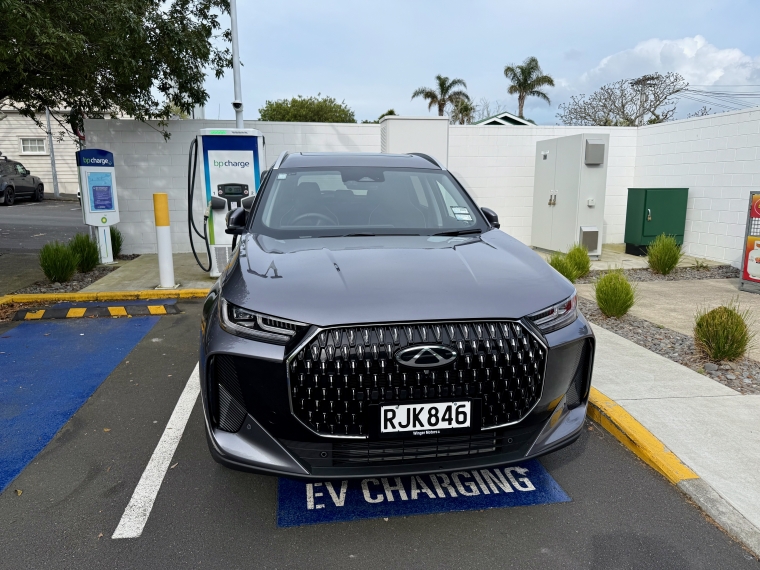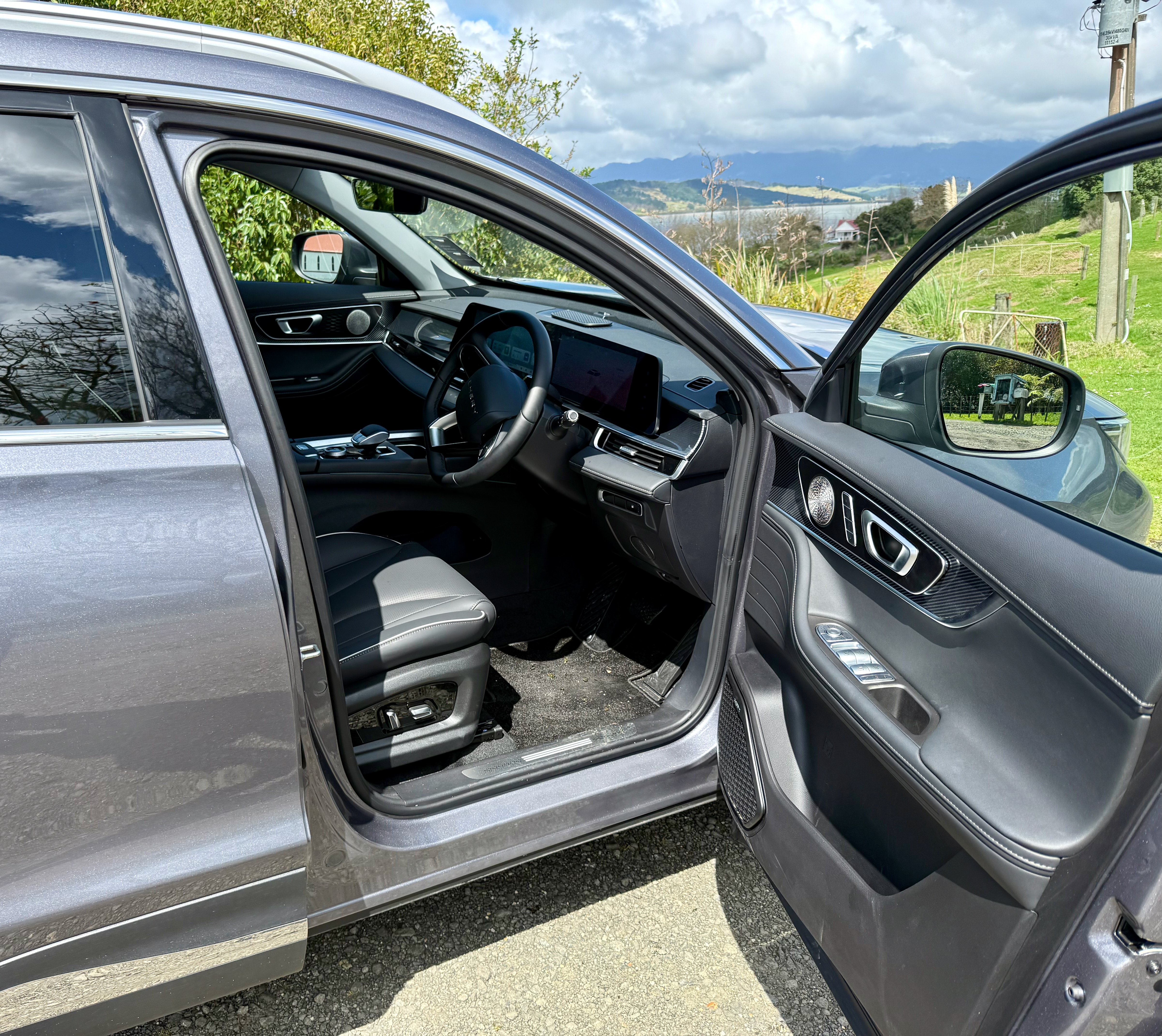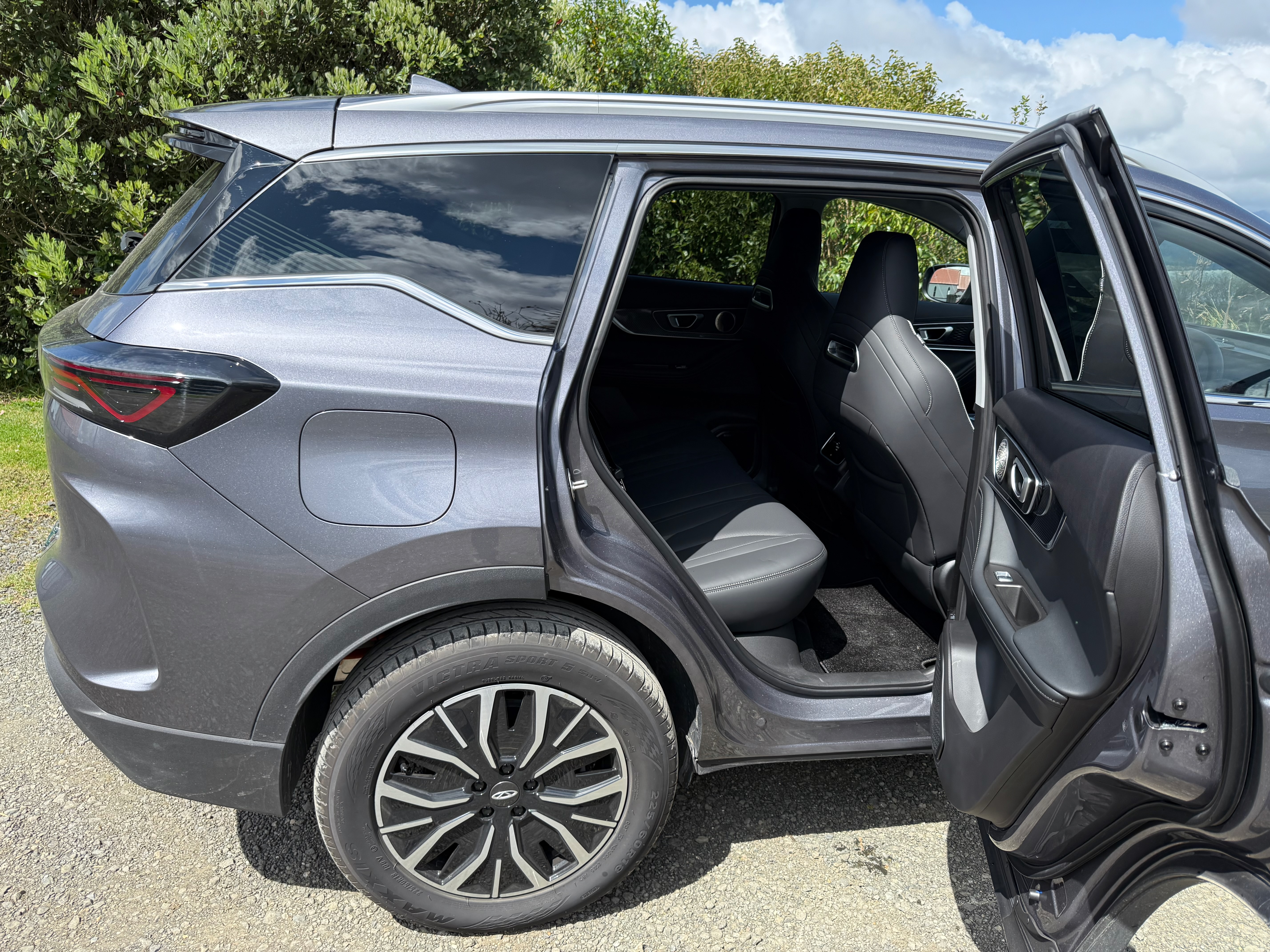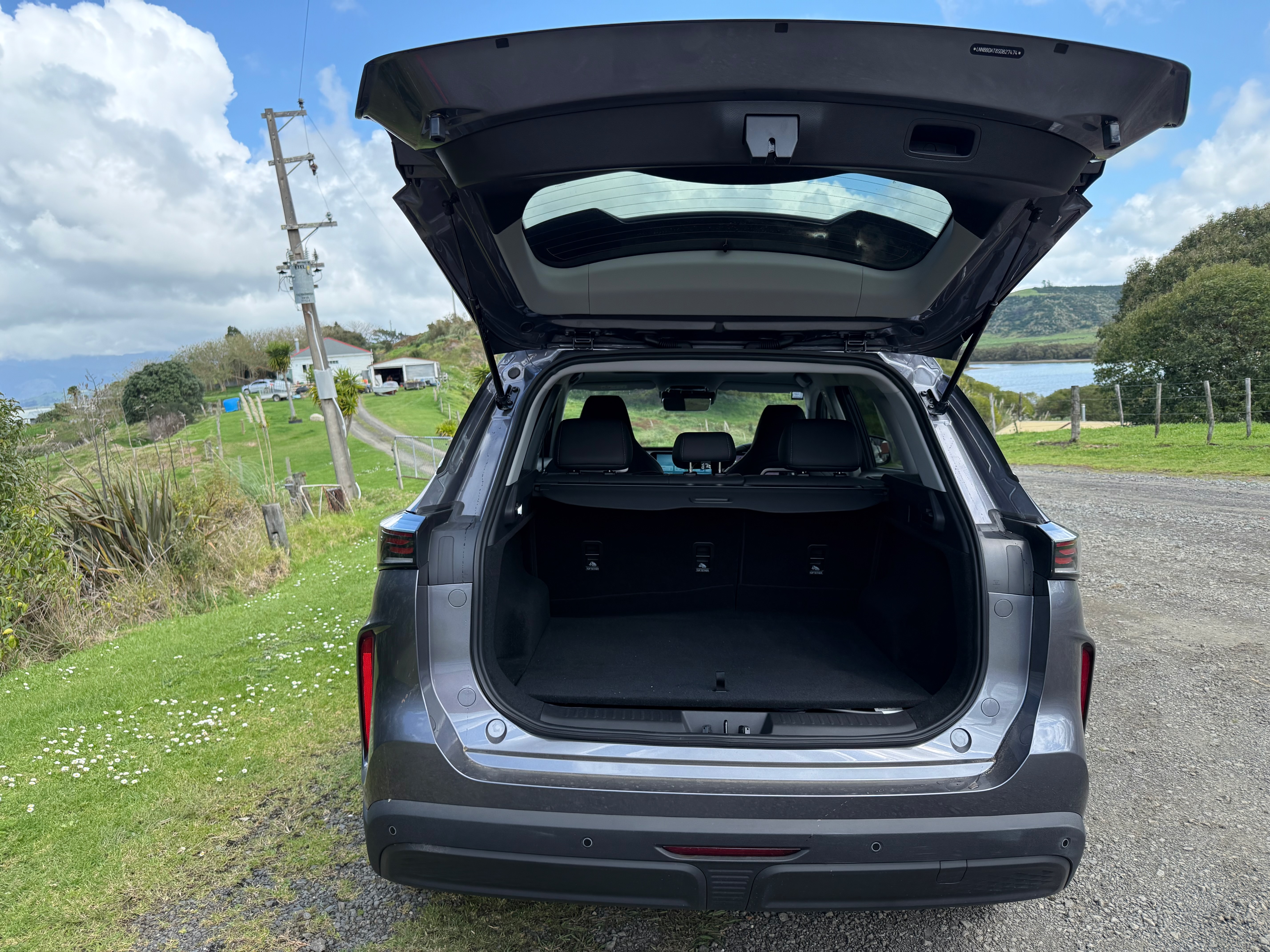
Over a year after the marque’s side brands Jaecoo and Omoda entered the New Zealand car market, vehicles carrying the logo of the Chery mothership are here. We’re late to the Chery vehicles, which have been available in Australia since 2023, along with other world markets.
It's a curious name, and I've seen different takes on its origin: qí rui (something like unique and auspicious), or that it was actually meant to be Cheery but ended up as Chery by accident. But that's going off on a tangent, just like Tiggo being something tiger related, apparently.
I drove the five-seater Chery Tiggo 7 Super Hybrid system (CHS) for just over a week, it’s priced at $46,990 for the Ultimate variant, which is front-wheel drive and comes with a petrol-hybrid electric (PHEV) drive train that features a largish 18.4 kilowatt-hour (kWh) lithium-iron phosphate battery for a 90 km EV-only range.
The factory warranty is a long seven years; for the battery, it is eight years and unlimited kilometres; I’m still waiting to hear how much the servicing will be for the Tiggo 7, and will update the story when I get that information.
Interestingly enough, Chery’s Australia-New Zealand chief, Lucas Harris, suggested the Tiggo 7 doesn’t necessarily need to have the battery topped up all the time. This is otherwise an Achilles heel of PHEVs, which require their batteries to be charged often to reach the nearly negligible fuel use figures advertised. Otherwise you’re hauling heavy depleted batteries around that don’t help propelling the vehicle.
Harris also reckoned I wouldn’t have to fill up the Tiggo 7 for the review period, as it boasts 1200 km of range from the battery and the 60 litre tank. Sceptical, I thought “we’ll see about that” wondering what the petrol consumption would be like when the battery state of charge dropped. Officially, the fuel consumption is given as 1.4 litres per 100 km,
Understated looks, quality interior and a big selection of features
Design-wise, the Tiggo 7 is Euro-inspired and doesn’t draw attention to itself with outlandish looks. Quite the opposite in fact. The review car came in a stylish Mercurial Grey and sits on aero-cover R18 alloy wheels.
The Tiggo 7 measures 4535 mm by 1864 mm by 1702 mm (L x W x H) and weighs 1788 kg (tare) and a gross vehicle mass of 2310 kg, for a payload of around 500 kg, and unbraked towing capacity of 750 kg.
This makes it a medium SUV by today’s standards, and good for city driving.
Hopping into the Tiggo 7, and you’ll sit SUV high in the faux-leather perforated seats that are both ventilated, heated and six-way power adjustable, with two memory settings for the driver’s side.
The seats are comfortable for longer trips, although I wish you could tilt the front of the driver’s one upwards; finding a good driving position is easy though, thanks to the rake and reach adjustable steering wheel.

Visibility is decent, with good sized auto-foldable and power adjustable wing mirrors and the bird’s eye view camera is high-resolution, making parking dead easy. A Sony branded eight-speaker sound system is included with the Ultimate spec Tiggo 7, and it sounds pretty good.
As I drive out of cellphone data coverage a lot, I like having a good, working podcast and streaming music alternative. It's called, ahem, a “radio”, and I thought the one in the Tiggo 7 was awkward to use with so-and-so reception.
Sitting in the front seats, there’s plenty of space. The Tiggo 7 isn’t a massive car, but there was good space in the back with the driver’s seat in a stretched-out position for myself at around 185 cm.

The interior feels much more premium than you’d expect for the price and is generally well thought out. Some of the Tiggo 7 features can be controlled via buttons beneath the 12.3-inch infotainment screen, and physical dials; ditto with buttons on the steering wheel.
This instead of using the vehicle settings in the infotainment screen. These are not complicated to use, there's voice recognition, and the system is responsive but buttons for common functions are better, although you can create shortcuts on the infotainment system for frequently accessed features.
Proximity car key fobs, automatic headlights and rain-sensing windscreen wipers on a car this price, along with other features such as tyre pressure and temperature monitoring, is pretty amazing.
I’m not sure that the power sunroof with a sliding cover (also powered) for the Ultimate is particularly useful, although some people will no doubt love it. To make the price point, there’s no power tailgate, but that’s a minor point.
Luggage space is a good 356 litres with the rear seats up. Drop the 60/40 split rear seats down, and you get 1500 litres of space (figures from overseas specs).

Driving away from home
Chery doesn’t give a total combined output figure for the electric and petrol engines, but it seems the Jaecoo 7 with its identical power train manages 255 kilowatts and 525 Newton metres.
The specifications for the Tiggo 7 state the 1.5 litre petrol engine produces 105 kW and 215 Nm of torque; add to that 150 kW and 310 Nm from the electric motor.
That’s quite a bit, and the Tiggo 7 can chirp the front tyres if you put the foot down while standing still. Although the zero to 100 km/h figure is somewhere in the 7.5 to eight second range, the Tiggo 7 is nicely responsive like an EV at low speeds, and moving off from the lights.
Shooting for the gap or overtaking, the Tiggo 7 feels like it has ample power; I really noticed the lack of linear EV acceleration after returning the Tiggo 7 and getting into my now-ancient petrol car that doesn’t have that electric motor immediacy at all.
The Tiggo 7 uses a single-speed dedicated hybrid transmission (DHT) to route power from the electric engine to the wheels, with the help of the petrol when the battery drops below 30 per cent. Switching between EV and petrol-backed HEV mods is smooth and unnoticeable.
Due to that single-speed DHT, the battery in the Tiggo 7 is never allowed to completely run out. Once the car’s computer decides more charge is needed, the petrol engine acts as a generator for the battery.
Handling is safe and steady, although the Tiggo 7 is a tall car with heft, and starts to understeer somewhat if you forget that. Most of the time, the Tiggo 7 is nicely quiet and comfortable. Particularly so in the city, and on Auckland motorways. On rougher roads, the suspension can thud at times, but it’s nothing too bad.
Also, on the coarse tarmac you get a little bit of tyre noise; and yes, the 1.5 litre petrol engine can be heard if you listen out for it but it’s never intrusive.
The Tiggo 7 has a full suite of active driver assistance systems (ADAS) as well. There’s not much to say about the ADAS which I thought functioned nicely. The adaptive cruise control was great, ditto the lane keeping which gently tugged at the steering wheel and the warning systems like the blind spot and speed monitors do not overdo the bing-bongs.
You get speed sign recognition in the multifunction dashboard, but there’s no heads-up display (HUD). Three levels of regenerative braking is available, but even at the highest setting you won’t be doing one-pedal driving which is a shame.
Did the Tiggo 7 go the distance?
Almost: I topped up the battery to full (normally you should charge it up to 80 per cent only) and filled up the 60 litre tank with 91. That gave an indicated 1050 km range.
The Tiggo 7 supports fast DC charging up to 40 kW which is great. Once you go over 80 per cent state of charge though, adding more electricity to the battery is slow on DC, taking what felt like forever (OK, 35 minutes) to reach 100 per cent.
Setting off, there was a bit of town driving, then State Highway 1 up to the Far North, with lots of hills and rough roads. Heading back to Auckland, I decided to take a road never travelled because Apple Maps suggested I should.
Driving, I couldn’t see the route Apple Maps picked for me, but it turned out to be mostly gravel, and very windy. If I was practising for a Rally New Zealand stage, perfect. I wasn’t of course, and while the Tiggo 7 travelled steadily enough across the gravel, I had misgivings about getting a puncture in the middle of nowhere without mobile phone coverage, and flubbing the tyre repair kit in case.
That scenario didn’t materialise, thank goodness. There was also no logging in the area so no sudden encounters with tree-laden trucks as you went round the bends. At least I got to see what’s down that route and it’s quite the Mad Max landscape with a huge amount of wrecked and rusting cars scattered all through it.
I didn’t stop to ask the locals why there are rusting car hulks everywhere, but let’s just say that next time I’ll be more careful with Apple Maps’ route suggestions.
Either way, the return to Auckland was undramatic. I did not top up the battery, or fill up the tank. Adding up the range left with what the trip meter showed, I got 1055 km.
Which is excellent, albeit short of the advertised 1200 km. I think it’s possible to reach the latter figure, maybe in Eco mode which dulled down the response of the car heaps, to the point that I switched back to Normal pretty quickly.
Likewise, the Sports mode made the Tiggo 7 feel a bit livelier, but it wasn’t a big difference compared to Normal; I suspect most people won’t use the Mode dial often, and leave the Tiggo’s electronics to decide when to run as an EV or an HEV.
Fuel consumption: if you want the lowest possible petrol use, keep the car battery topped up whenever possible, and drive for 70-80 km as an EV. However, as Harris said, it’s no disaster economy-wise to not do that. I saw between 4.5 to 5.5 l/100 km in mixed driving in the Tiggo 7, which is very good.
Value for money? Totally.
For the money, the Tiggo 7 offers a lot of car. You’d have to be really picky to find faults with the car, like the black box on which the windscreen rear view mirror is mounted being on the big side, blocking some of vision for taller drivers (in overseas Chery/Jaecoo models it can house a dashcam with a memory card).
A proper spare wheel, even a space saver one, would’ve been great to have instead of the included tyre repair kit. I’ve never used one of those, and the neurotic old me feels like they can’t be trusted (but I could be wrong).
Other than that, the Tiggo 7 makes a great deal of sense as a family car, ticking the vast majority of boxes for most people.
There’s a slightly lower priced variant of the Tiggo 7 available too, the Urban model, priced at $42,990. Seriously though for just $4000 more, the Ultimate brings really useful features to the table such as the overview cameras, Qi-pad wireless charging, ambient lighting and those heated/ventilated seats, and I think the top-spec variant is the one to go for.
As for alternatives, one oddity in the Chery stable is the very similar Jaecoo 7 SHS which seems to be built on the exact same platform as the Tiggo 7, but costs a few grand more. Winger is Chery’s partner dealership in New Zealand, and I spoke to some friendly staffers in Auckland about the Chery-Jaecoo relationship, but they couldn’t tell me why there are two nearly identical vehicles but from different brands.
You could look at the Mitsubishi Eclipse Cross VRX PHEV which provides the marque’s very good AWD system, but in a car that costs $5000 more and that offers less power, range and space.
A scout around for a direct competitor to the Tiggo 7 CHS doesn’t throw up any obvious options for a similar price. Not from established makes, or the new Chinese brands.
Time will tell how well Chery does in NZ but the Tiggo 7 CHS PHEV is a very strong offering at a great price point.
2 Comments
I rented the Chery 7 in Spain where it's badged "EBRO" (almost sounded like I was back in NZ, lol). I was very impressed with the interior quality and all the comfort, and it totally changed my preconceived idea of hybrid cars. Immediate power early on and no range anxiety with the petrol engine charging the battery. I didn't like the driving dynamics and the intrusive "driver aids" much, but it certainly represents incredible value for the price. So I just recently bought an Omoda 9 (yes, a Chinese car!), and I'm loving it, including its… 537 HP of power !
There might be another scale upon which to rate vehicles: how much it surveilles you and how much data goes back to firms like, say, insurance companies...and does the vehicle have a modem and data recorder?
https://www.fastcompany.com/91175277/general-motors-texas-driver-data-r…
https://www.texasattorneygeneral.gov/news/releases/attorney-general-ken…
https://www.afslaw.com/ftc-makes-statement-connected-vehicle-data-major…
https://topclassactions.com/lawsuit-settlements/lawsuit-news/hyundai-cl…

We welcome your comments below. If you are not already registered, please register to comment.
Remember we welcome robust, respectful and insightful debate. We don't welcome abusive or defamatory comments and will de-register those repeatedly making such comments. Our current comment policy is here.